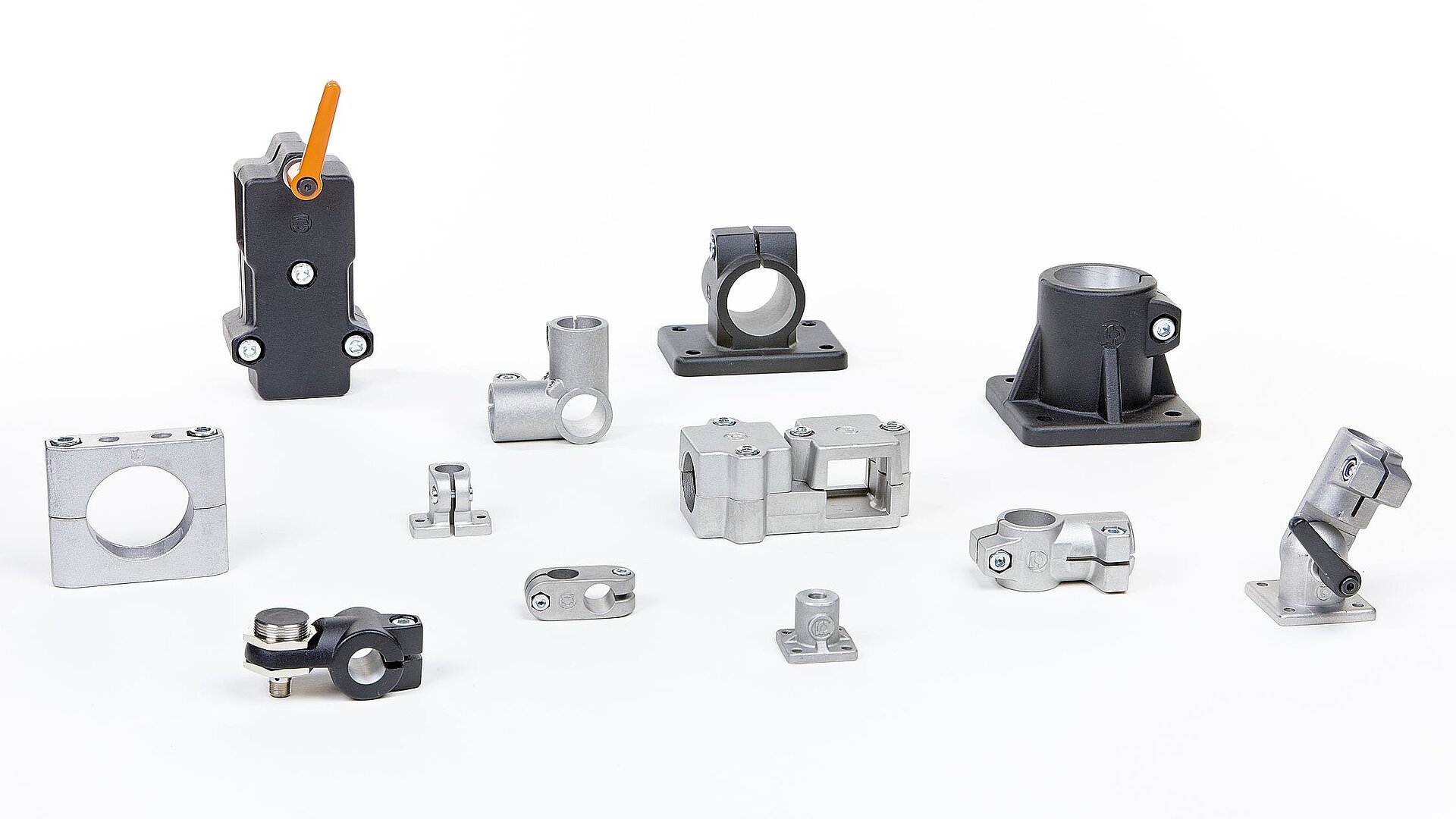Connecting tubes
Tubes are closed hollow profiles with a consistent cross-section. The serve as structural elements or as lines for carrying media. Various types of connections are available depending on the application, load, and duration of use.
What types of tube connections are there?
When a tube system is used as a media line for gases or liquids, a good seal between the tube pieces is an indispensable feature of the connection type. This limits the selection of possible tube connections. In a structural tube system, on the other hand, the seal between individual tube elements is irrelevant. Clamps serve as suitable connectors for such systems. When vibratory polished, they are easy to slide over the tubes, fix in place, and release again, if necessary.
Typical tube connection methods are:
- Flanging
- Compressing
- Soldering
- Welding
- Gluing
Permanent tube connections
Tube connections can generally be divided into permanent and detachable tube connections. Permanent connections cannot be separated again without destroying the parts. The following connections are typical ways to permanently join tubes:
- Welding
- Soldering
- Compressing
- Gluing
Detachable tube connections
Detachable tube connections are good choices for expanding a tube system by adding valves and devices. They can always be removed from the tube system and replaced at a later time. However, a gradual decrease in the effectiveness of the seal must be considered. Replacing the seals at appropriate intervals is an effective way to prevent leaks. The line system should always be designed such that the seals are easily accessible.
Detachable tube connections are always bolted or screwed into place. Depending on the application and internal pressure in the system, the following solutions are available:
- Compression fittings
- Threaded tubes
- Flanged tubes
- Union fittings
- Push-fit connectors
- Tube couplings
Tube connectors are separable clamping blocks. The two halves of the connector are fitted over the location where the tubes join. Then the connector is tightened into place with at least two screws. The connection is established via the clamping force of the tube connector.
Threaded tubes, such as water pipes, have a male thread at the end. This can be connected to the next tube by means of standardized connection pieces. With tees, branches, and elbows, it is possible to assemble tube systems of any level of complexity.
Flanged tubes have a round plate with holes at the end. Bolts can be inserted through the holes in the plate. Flanged tubes are suitable for high to very high internal pressures.
Union fittings, couplings, and push-fit connectors result in only weak tube connections. They are not suitable for media lines with high internal pressures. However, they are easy and quick to remove and replace. Clamps are available in robust stainless steel for the chemical and pharmaceutical industries as well as food processing. For other areas, tubes of lightweight aluminum are available.
Connecting tubes with tube connectors
In addition to use as media lines, tube systems can also serve as structural elements. Due to their high resistance to bending, tubes are excellently suited for scaffolds, enclosure support systems, railings, and many other applications. Structural tube systems are not used as media lines. Tube connectors have proven themselves to be ideal for creating flexible but extremely sturdy tube constructions. They offer the following advantages:
- Unlimited disassembly, making them ideal for temporary uses
- Ability to combine round and square tubes
- Welding is unnecessary; the system can be adapted as needed by shortening standard tubes
- Large selection of materials and sizes for maximum design flexibility
Pipe connectors are completely separable. They are suitable for the following uses:
- Creating a butt joint between two tubes of the same cross section
- Connecting other elements at any location
However, tube connectors are not limited to linear joining of two tubes. With the right product, it is also possible to create right angle connections or even rotating connections.
The stability of the tube connector must be selected appropriately for the weight of the connected tubes and the static forces within the entire system. Typical materials for these parts are:
- Steel
- Stainless steel
- Aluminum
- Magnesium
Steel and stainless steel are good choices for especially stable pipe connections, such as in scaffold and stage construction. Aluminum and magnesium are light metals. They are lighter in weight but cannot withstand the same bending stresses as tube connectors of steel or stainless steel. For this reason, they are used primarily for constructions that do not carry significant loads, such as for signs, banners, or railings.
In the CLAMPS PRODUCT OVERVIEW you will find a large selection of suitable assembly materials for building structural tube systems.
Connecting tubes with INOCON
INOCON is a specialist in tube connectors. The high-strength parts made of rustproof aluminum or robust stainless steel fit all standard cross-sections of round and square tubes. The clamping force of a single screw is sufficient for establishing a reliable connection. The tube connectors remain permanently in place without slipping and are unaffected by vibrations. The wide selection of connector types ensures maximum flexibility in the form of a modular system. The following shapes and designs can be found in INOCON’s tube connector range:
- Cross connectors
- Flange connectors
- Elbows
- Sensor mounts
- Articulated joints
- Parallel connectors
- Adapters from square to rectangular
And many more
INOCON supplies its products to any industry for every type of application. The connectors can accept high loads and create solid connections. They can be detached without damage and reused as often as desired.
Contact
Do you have a special challenge in the field of research and development? Then contact us! We look forward to your inquiry and will help you find just the right solution for your application.



